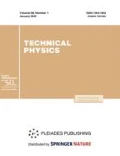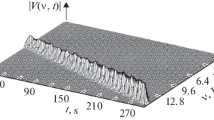Abstract
A mathematical model is proposed for a frequency-modulated signal in the form of a system of Gaussian peaks randomly distributed in time. An analytic expression is obtained for continuous wavelet transform (CWT) of the model signal. For signals with time-varying sequence of peaks, the main ridge of the skeleton characterized by frequency ν MFBmax (t) is analyzed. The value of ν MFBmax (t) is determined for any instant t from the condition of the CWT maximum in the spectral range of the main frequency band (MFB). Double CWT of function ν MFBmax (t) is calculated for a frequency-modulated signal with a transition regions of smooth frequency variation (trend) as well as with varying frequency oscillations relative to the trend. The duration of transition periods of the signal is determined using spectral integrals E ν(t). The instants of emergence and decay of low-frequency spectral components of the signal are determined. The double CWT method can be used for analyzing cardiac rhythms and neural activity, as well as nonstationary processes in quantum radio physics and astronomy.
Similar content being viewed by others
References
S. Mallat, Wavelet Tour of Signal Processing, 3rd ed. (Academic, New York, 2008).
A. A. Koronovskii and A. E. Khramov, Continuous Wavelet Analysis and Its Applications (Fizmatlit, Moscow, 2003).
K. Chui, Introduction to Wavelets (Academic, New York, 1992).
N. K. Smolentsev, Wavelet Theory Principles. MATLAB Wavelets (DMK, Moscow, 2008).
I. Daubechies Ten Lectures on Wavelets (SIAM, Philadelphia, 1992).
A. Cohen, Numerical Analysis of Wavelet Method (Elsevier, Amsterdam, 2003).
Advances in Wavelet: Theory and Their Applications in Engineering, Physics and Technology, Ed. by D. Baleanu (InTech, Rijeka, 2012).
S. V. Bozhokin and N. B. Suvorov, Biomed. Radioelektron., No. 3, 21 (2008).
S. V. Bozhokin, Tech. Phys. 55, 1248 (2010).
S. V. Bozhokin, Tech. Phys. 57, 893 (2012).
A. V. Tankanag and N. K. Cheremis, Biofizika 54, 537 (2009).
O. V. Sosnovtseva, A. N. Pavlov, E. Mosekilde, N. H. Holstein-Rathlou, and D. J. Marsh, Physiol. Meas. 26, 351 (2005).
P. S. Addison and J. N. Watson, Int. J. Wavelets Multiresolut. Inform. Process. 2, 43 (2004).
A. N. Pavlov, A. E. Khramov, A. A. Koronovskii, E. Yu. Sitnikova, V. A. Makarov, and A. A. Ovchinnikov, Phys. Usp. 55, 845 (2012).
U. R. Acharya, K. P. Joseph, N. Kannathal, C. M. Lim, and J. S. Suri, Med. Biol. Eng. Comput. 44, 1031 (2006).
V. M. Tikhonenko, Practical Work on Holter Monitoring (BKhV, St. Peterseburg, 2012).
S. V. Bozhokin, E. M. Lesova, V. O. Samoilov, and P. I. Tolkachev, Biofizika 57, 696 (2012).
G. D. Abarbanel’, M. I. Rabinovich, A. Selverston, M. V. Bazhenov, R. Khuerta, M. M. Sushchik, and L. L. Rubchinskii, Phys. Usp. 39, 337 (1996).
A. V. Chizhov and L. J. Graham, Phys. Rev. E 77, 011910 (2008).
I. V. Zhdanova, K. Masuda, S. V. Bozhokin, D. L. Rosene, J. González-Martínez, S. Schettler, and E. Samorodinsky, PLos ONE 7, e33327 (2012).
A. G. Chirkov and B. G. Matisov, Modern Theory of Stability of Precision Generators (Politekh. Univ., St. Petersburg, 2010).
V. Giordano and E. Rubiola, Lect. Notes Phys. 550, 175 (2000).
W. J. Riley, Handbook of Frequency Stability Analysis (Nat. Inst. Standards Technology, Washington, 2008).
A. I. Ryabinkov, A. A. Kaurov, and A. D. Kaminker, Astrophys. Space Sci. 344, 210 (2013).
I. Backus, D. Mitra, and J. M. Rankin, Mon. Not. R. Astron. Soc. 404, 30 (2010).
A. Lyne, G. Hobbs, M. Kramer, I. Stairs, and B. Stappers, Science 329, 408 (2010).
J. L. Herfindal and M. J. Rankin, Mon. Not. R. Astron. Soc. 380, 430 (2007).
Author information
Authors and Affiliations
Corresponding author
Additional information
Original Russian Text © S.V. Bozhokin, I.M. Suslova, 2013, published in Zhurnal Tekhnicheskoi Fiziki, 2013, Vol. 83, No. 12, pp. 26–32.
Rights and permissions
About this article
Cite this article
Bozhokin, S.V., Suslova, I.M. Double wavelet transform of frequency-modulated nonstationary signal. Tech. Phys. 58, 1730–1736 (2013). https://doi.org/10.1134/S1063784213120074
Received:
Published:
Issue Date:
DOI: https://doi.org/10.1134/S1063784213120074




